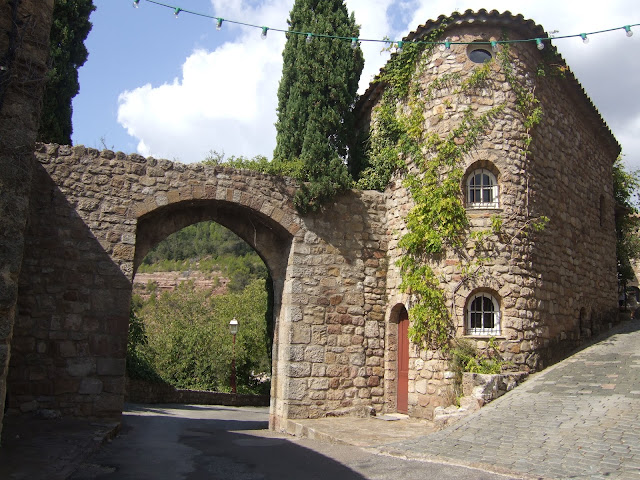 |
| One of four gateways to Le Quartier Medieval - showing restoration stonework. |
I am often struck by the synchronicity that occurs in life. It
happened after I was walking back to the town from the supermarket the other
day and noticed how the old town – Le
Parage – looked so ‘settled’ in its environment.
 |
| The vieille ville blends with its background. |
Its stones have weathered into their surrounds and in that
light, the original town was barely distinguishable from its background, the
tonal values being almost identical.
In contrast, the newer parts of Les Arcs stand out with
their brighter tiled roofs, pale pastel and ochre walls – not yet so perfectly
at home in their surrounds.
A favourite visual
for me is the effect of raking light an uneven wall, particularly the
undulations of a stone wall.
So I thought, why not look at the stones in Les Arcs? The
medieval village, known here as Le Parage,
is built of ancient and weathered sandstone. And this is where the
synchronicity came in. |
| Stonework in the tower or donjon from the 13th century. |
In the local paper that same day, I saw there was an
exhibition nearby based on the art of dry-stone walling across the Var.
There are thousands of crumbling dry-stone terraces here which were once built on the hillsides for vineyards and olive groves.
Then four days ago, scaffolding went up around the arched entry to Le Parage at the end of our street so workers could clean and repoint the ancient stones.
There are thousands of crumbling dry-stone terraces here which were once built on the hillsides for vineyards and olive groves.
Then four days ago, scaffolding went up around the arched entry to Le Parage at the end of our street so workers could clean and repoint the ancient stones.
 |
| Slanting light highlights the stonework. |
I am not sure whether dry-stone was the original method of
building when our medieval village was constructed. In some areas there is
precious little mortar between the stones, but in others, there is almost all
mortar, almost casually studded with stones.
The earliest buildings are constructed of large, square,
softly-rounded and dressed stones, which must have been back-breaking to haul
up onto the rocky outcrop where the village was established.
Stonework in the buildings renovated since the 1960s has
been beautifully done with great care to keep the village as authentic as
possible.
 |
| The rubble wall next door. |
Yet in the village – generally hidden from view – there are
walls of pure rubble, rocks that appear to be tipped together without a thought
of setting them straight or balancing them.
There is a different type of stone that forms the shallow
steps that wind up and through the village. They are studded with mica deposits
and glitter underfoot. I have also noticed this in other villages.
Maybe this stone was mined in the Maures Mountains, which separate Les Arcs from the coast and are
full of minerals, but that is another story!
 |
| The Place de la Rondourette where four of the small, pedestriansed ruelles meet, showing the wide, shallow steps. |
It is true that in summer, at midday, the reflected heat
from the walls and the ground can be overwhelming, but it is countered by the
high, narrow passages, which encourage cooler breezes to twist refreshingly
through the streets.
The medieval quarter is pedestrianised, but workmen use little motorised wheelbarrows
to negotiate the steps for large or heavy deliveries.
Over recent centuries, Le Parage fell into disuse and by the 1960s the townsfolk and some of the council were considering pulling it down entirely.
However one enterprising Mayor, M. Raoul Textoris (Mayor 1945-1971), initiated the restoration work .
A group, Les Amis du Parage, was formed to help save the village and preserve it for the future.
 |
| Part of Le Parage before the decision to restore the medieval quarter. |
Over recent centuries, Le Parage fell into disuse and by the 1960s the townsfolk and some of the council were considering pulling it down entirely.
However one enterprising Mayor, M. Raoul Textoris (Mayor 1945-1971), initiated the restoration work .
A group, Les Amis du Parage, was formed to help save the village and preserve it for the future.
They were more than successful. Gradually the old town was
restored – and there followed an influx of people wanting to buy cheaply and
renovate (the view is spectacular) – and this contributed to the fully restored village you see today.
 |
| The medieval Church of St Pierre du Parage showing its stonework. It remained largely intact through the centuries. |
Now a tourist drawcard, it is one of the best preserved – and fully inhabited –
medieval villages in Provence. It houses the starred Logis du Guetteur restaurant and accommodation, with regular art exhibitions and musical events in the Church of St Pierre du Parage.
Guided tours (in French), which tell the village’s history,
the history of the Villeneuve family who lived in the chateau above and the
story of its reconstruction – are offered regularly.
And I’m sure if the stones could speak they would have a lot
more to add.
I have been writing of rocks and stones to the North of France - Normandy and Brittany. How interesting that we should connect in such a way. Visually dramatic and verbally adept!
ReplyDeleteThanks Barb, I think it's the shapes, colours and play of light and shade at different times of day that make them so changeable, despite their solidity.
ReplyDelete